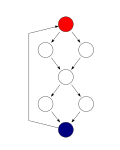This article includes a list of general references, but it lacks sufficient corresponding inline citations .(August 2012) |
In computer programming, program slicing is the computation of the set of program statements, the program slice, that may affect the values at some point of interest, referred to as a slicing criterion. Program slicing can be used in debugging to locate source of errors more easily. Other applications of slicing include software maintenance, optimization, program analysis, and information flow control.
Contents
- Static slicing
- Example
- Lightweight forward static slicing approach
- Dynamic slicing
- See also
- Notes
- References
- External links
Slicing techniques have been seeing a rapid development since the original definition by Mark Weiser. At first, slicing was only static, i.e., applied on the source code with no other information than the source code. Bogdan Korel and Janusz Laski introduced dynamic slicing, which works on a specific execution of the program (for a given execution trace). [1] Other forms of slicing exist, for instance path slicing. [2]
